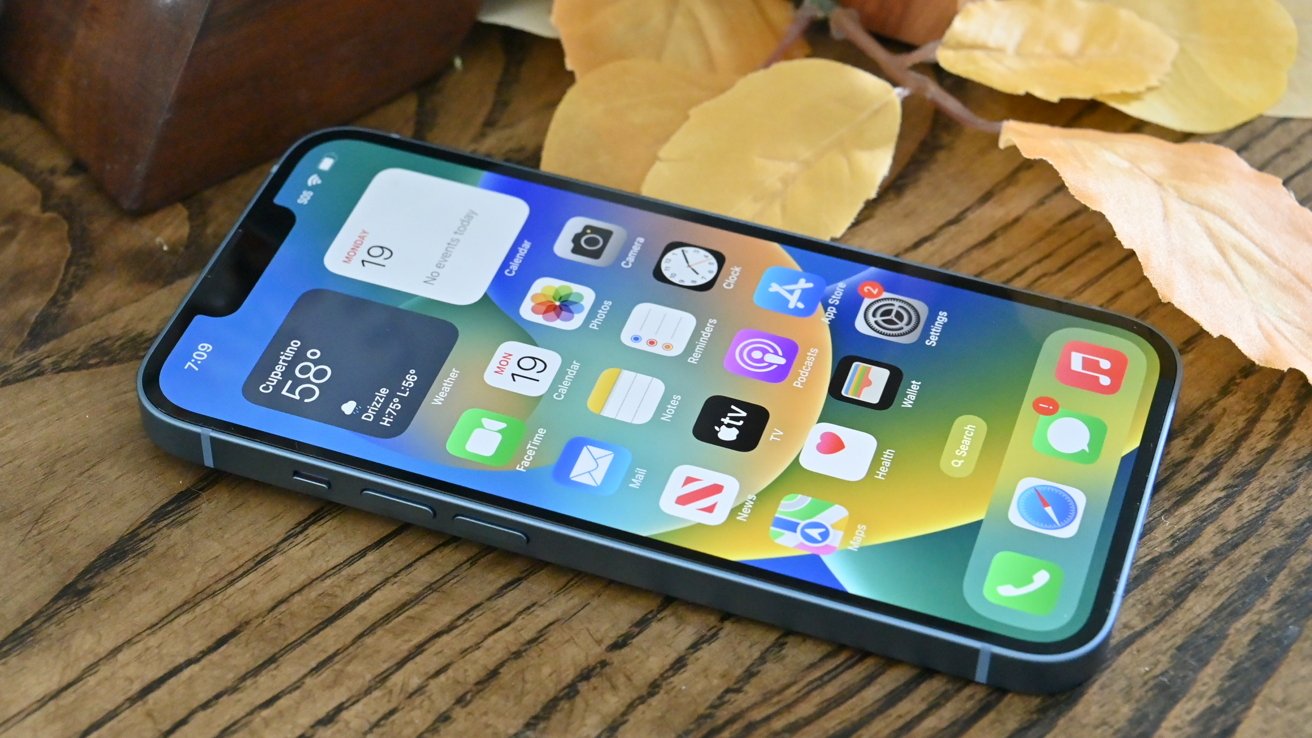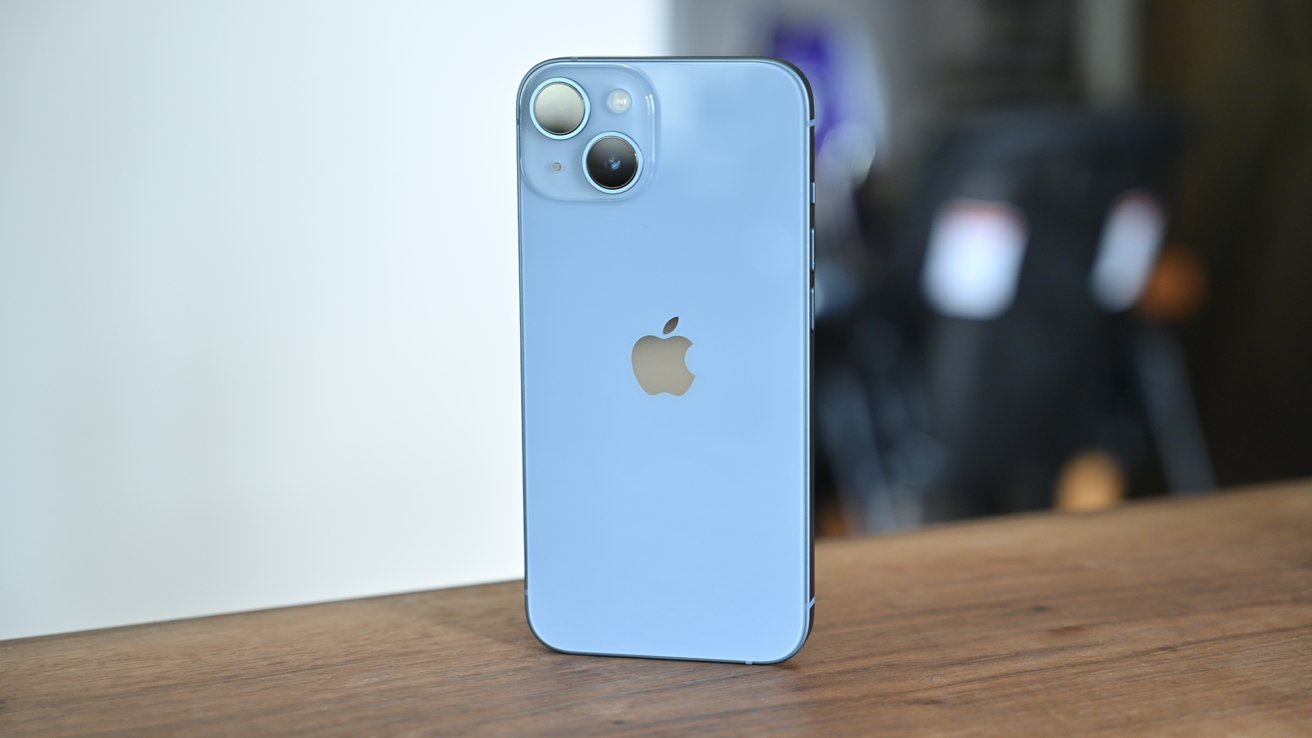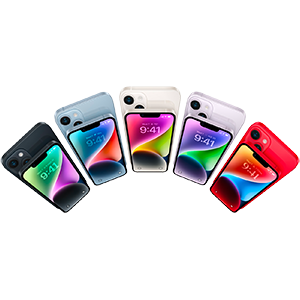At a glance, the iPhone 14 is indistinguishable from the iPhone 13, but camera improvements and extended battery life give it a shot to win over long-time upgrade holdouts.

iPhone 14 looks similar to iPhone 13
Apple's iPhone 14 sits in a spot that has previously been occupied by the prior year's model, which still exists. It's an interesting choice in a still-challenging production and economic environment, as Apple's design decisions have thrown purchasers a curve ball.
But, once you see that the pitch is a curve ball, it's easy to figure out if you want to swing at it -- assuming it's in your strike zone.
iPhone 14 is an iterative step up
With the iPhone 14, Apple kept the same storage tiers as the previous generation with 128GB, 256GB, and 512GB capacities. Available colors include Blue, Purple, Midnight, Starlight, and (Product)Red, giving a decent amount of variety.

The blue iPhone 14
The iPhone 14 has nearly the same dimensions as the iPhone 13. It is 5.78 inches tall and 2.82 inches wide, but slightly thicker at 0.31 inches versus 0.29 inches for the previous model.
The screen is pretty much unchanged from the iPhone 13, with the iPhone 14 using a 6.1-inch Super Retina XDR display. That's an OLED screen with a 2,000,000:1 contrast ratio, HDR support, Wide Color (P3), True Tone, and Haptic Touch.
The resolution's also identical at 2,532 by 1,170 pixels, giving a pixel density of 460ppi. Brightness is, likewise, static at 800 nits of typical brightness, 1,200 nits at peak for HDR content.
The camera bump is about the same size -- but there are enough differences that most cases that work with the iPhone 13 will not fit the iPhone 14.
MagSafe continues to be a staple in the iPhone lineup with dozens of great accessories on the market. Apple didn't change anything about MagSafe, so previous accessories and chargers will work exactly as before.
iPhone 14 face down
The Lightning port returns for perhaps its final time as Apple is again rumored to move to USB-C in the iPhone 15. It still offers fast charging at 20W for 30 minutes to get 50% of the battery capacity.
Of course, this comes at a tradeoff. Faster charging means more heat, which can shorten the overall iPhone battery health in the long term. We've already gone into this in some depth, several times, so we won't go into the hows and whys again here.
Apple updated Bluetooth to version 5.3, which theoretically allows a higher bandwidth signal over the previous version 5.0 used in earlier models. This isn't really a "today" technology, as we discussed in the iPhone 14 Pro review we published on September 17, but it will help for longevity.
The 5G speeds (but not the modem), WiFi 6, and U1 Ultra Wideband chip remain identical to the iPhone 13. However, Apple went all in on eSIM for iPhone 14.
Customers in the United States don't have a SIM card slot and will have to transfer to eSIM through their carrier. In international markets, the iPhone 14 will still have a SIM tray and support for dual eSIMs.
In the long run, this is good. In the short term, it's been anything but.
We've been testing the iPhone 14 lineup since Tuesday, courtesy of the same testing facilities we've used in the past. Even after running into some trouble early when servers weren't being crushed by literally millions of activations, things haven't gotten much better.
Two full days after release, on September 18, the carriers are still getting hammered, and customers are running into problems. Anecdotally, T-Mobile seems to be having the most problems, with AT&T the least.
A SIM to eSIM migration isn't instant, regardless of carrier, and regardless of whether it's after an iPhone launch or another time of the year. Early adopters should expect a wait, and how much this gets better is yet to be seen -- but we do expect it to get at least some better.
What's new with iPhone 14
While a lot remained the same, Apple brought on several worthwhile feature updates and changes that make considering a new iPhone a little easier. Camera improvements, a higher performance processor, and safety features set this model apart.
Camera upgrades
Apple upgraded the Main Camera, previously referred to as the Wide Camera. It still uses a 12MP sensor, not the 48-megapixel as introduced in the iPhone 14 Pro, but it is larger and equipped with bigger 1.9-micron pixels and an f/1.5 aperture.
These specs translate to improved low-light performance, which Apple says is 49% better than the iPhone 13's camera. That means Night Mode won't kick in as often as it did previously, and Portrait mode photos benefit from brighter exposure and more detail.
When Night Mode does kick in, it can take shots in half the time for the same light conditions. This can reduce blur and sharpen darker environments, but it can be very hard to see the difference unless you're actively looking for them.
The selfie camera, which Apple calls the TrueDepth camera, is also upgraded with a better 12MP camera, as well as an f/1.9 aperture and autofocus. It's a bit easier to see the differences here.
The new autofocus mode will ensure images are in focus for multiple distances, such as if you're taking a group selfie and not everyone's stood in a line.
It also works with the depth sensors in a hybrid system to make autofocus faster. This is the same sort of assistance the LiDAR in the Pro models offers, simply by being able to create a depth map that can tell the camera system how far away everything is from the lens.
Alongside new camera hardware, Apple introduced a new image capture pipeline called Photonic Engine. In short, it moves the Deep Fusion computational photography smarts earlier in the pipeline, in order to preserve colors and detail.
Apple says the Photonic Engine will help improve low-light photos across every camera by twice as much or more.
iPhone 14 camera bump
Other features remain the same for capturing still images, such as Smart HDR4 for photos, Portrait Mode with Portrait Lighting and Photographic Styles, and a Retina Flash.
For video, Apple introduced Action Mode for a software-based video stabilization feature. It uses the entire sensor with more overscan and advanced roll correction to create smooth video without a gimbal.
The rest of the video specifications are pretty much unchanged from the year-ago launch, including 4K HDR in Dolby Vision at 60fps, 1080p 240fps Slo-mo, Sensor-Shift OIS, a 2x optical zoom out and a 3x digital zoom, and time-lapse modes. Cinematic mode does get a bump, with it going from 1080p 30fps to 4K HDR 30fps.
Safety features
The iPhone 14 has a high dynamic range gyroscope and dual-core accelerometer to enable Crash Detection. This feature can sense up to 256g of force to determine if a car crash has occurred, as well as using other onboard sensors to detect various other aspects of a crash.
Since Crash Detection is also available in the Apple Watch Series 8, both devices will work together to contact authorities.
As far as that cellular modem goes, it's the Qualcomm X65 that Apple used to introduce Emergency SOS via Satellite. Users who find themselves far from cell towers in an emergency can connect their iPhone directly to a satellite to reach help.
We've covered this at some length already, but in short, if you are stranded somewhere in North America where you don't have cellular coverage, and you need help, you can still get it.
This is not StarLink, where satellites mock a cell tower. This is literally point-to-point communication from the iPhone to the satellite.
iPhone 14 support satellite connectivity in an emergency
Rather than a phone call or a full text message, the iPhone will ask questions about the situation, then it will tell you to point it at a satellite. Once a connection is made, the answers, along with the iPhone's location, Medical ID, and battery level, are sent to the satellite.
That message is then sent to an emergency service provider. If the service provider can't be texted, the message will go to an Apple-operated emergency relay center who will then summon that help.
This is not a fire-and-forget thing, though, and it will still need the caller to point the phone in the right direction for a short amount of time. The iPhone itself assists with this, telling you how to adjust the iPhone to get the signal to the satellite so it can be relayed.
Some napkin orbital math that we did earlier, and since confirmed with some experts, suggests that users will need about a 2-degree traversal of the phone as the message is sent, assuming the user is in clear terrain. It will need about a 5-degree swing in obscured environments like a forest.
Without Apple's help, which we don't have, this isn't testable now. And, Apple isn't going to have the service operational at launch, with it going live in November. Also, Apple says it will be free for two years, though it isn't clear what happens after that point.
A15 Bionic returns
One of the most surprising announcements at the iPhone event was that the iPhone 14 would be using last year's chip. It has the A15 Bionic with a 5-core GPU, which was used in the iPhone 13 Pro lineup previously.
While it, and the 6GB of RAM in the iPhone 14 is an upgrade over the 4-core GPU A15 used in the iPhone 13, spotting a real difference will be hard -- if you're coming from an iPhone 13. It will be clear as day for upgraders from anything older, and also if you're an avid benchmark enthusiast.
It isn't clear what the A15 Bionic enables that it couldn't before, but some new features are exclusive to the iPhone 14 lineup. For example, Cinematic Mode now works at 4K 30fps across all iPhone 14 models since the processor does play a part in image processing.
The extra GPU core will provide a boost to anything graphical, simply because there will be more cores at work. That will chiefly improve games, but it may also help make the interface of demanding apps a little bit snappier.
In Geekbench 5, the iPhone 14 scored a 1733 and a 4641 on the single and multi-core tests respectively. These are near identical scores to the iPhone 13 which scored 1742 and 4768. While the iPhone 13 scored a bit better on the multi-core, this is all within the margin of error and those CPUs are basically the same.
We see the benefits of that additional GPU core with the Compute graphics test. Our iPhone 14 managed a 12909 while the iPhone 13 pulled a 10795. The GPU can be (slightly) felt in Antutu also.
Antutu put the iPhone 14 at 803874 and the iPhone at 796250 as the cumulative totals. Looking at the breakdown, the scores were very similar with the biggest boost coming to the GPU and UX results.
While this processor isn't anything close to what you could call "slow," it is a departure from Apple's usual method of using the same chip across an entire model.
If we had to guess, a year ago when final design decisions were made on the iPhone 14 line, Apple looked at the competition, considered its rivals as being more than a year behind in processing power, and decided to differentiate the line more. This, combined with an expensive and challenging year for manufacturers, which only now is starting to show signs of recovery, led the company to what we got.
The battery life is also slightly improved. Apple says that the iPhone 14 is rated at one hour higher than the iPhone 13 -- 20 hours of local video viewing versus 19 hours. This is about what we realized in testing.
This continues into streaming video, with the iPhone 14 managing up to 16 hours versus 15 hours for the iPhone 13. Audio playback is a lot more, at up to 80 hours against 75 hours.
Given the physical changes of the iPhone aren't significant, Apple couldn't have changed the battery in a significant way between the two generations. It's probable that the benefits stem from other performance improvements that Apple has achieved, rather than simply more battery capacity.
Should you buy the iPhone 14?
In a vacuum, the iPhone 14 is a solid flagship phone, with a decent mix of features for the price. But, it doesn't exist in a vacuum. Existing iPhones surround it on all sides of the price and performance spectrums.
That iPhone 14 is very slightly faster than the iPhone 13 -- which is still available for $699, versus $799 for the 14. The rear camera is about the same, generating about the same quality of photos that the iPhone 13 did under normal usage conditions.
The new front-facing camera is a bit better. And, Apple's emergency satellite communications feature is in the iPhone 14 as well.
Using the new iPhone 14
It's very nearly identical to the iPhone 13 in design, weight, screen, and nearly every other factor that differentiates one phone from another externally. The Dynamic Island on the iPhone 14 Pro hasn't moved over, because it still has the notch.
In short, the iPhone 14 is a good phone. It's just a terrible choice, and just outside the strike zone, for anybody upgrading from an iPhone 13 of any flavor. There's not really enough new here to warrant switching fairly similar devices that are one year apart. And, if you're looking at it coming from an iPhone 12, you might want to wait for another year unless your phone is falling apart.
Those forecasting the possibility of getting into danger in a remote location and desperately needing that rescue-summoning satellite communications feature may find it an attractive option. But if you think you might need rescue gear, dedicated equipment and hardware for that purpose will be a far better investment.
Despite all the poor comparisons from the iPhone 13 to the iPhone 14 non-Pro, non-Plus, the iPhone 14 will still sell well through 2022 and 2023 because iPhone upgrade cycles keep getting longer and longer. We've all crossed the line where a low-end device is good enough for the iPhone-as-appliance crowd some time ago.
After the first month when the Apple devout are the first buyers and will clamor for the iPhone 14 Pro, it and the iPhone 14 Plus will surge higher. It is squarely in the strike zone for millions of users who still own an iPhone X, or a second-generation iPhone SE that don't see value in getting a "Pro" iphone.
iPhone 14 - Pros
- New emergency communication features
- More RAM, but how much this matters to any given user, varies
- eSim migration is will be good in the long run, but...
iPhone 14 - Cons
- eSIM migration is really rocky around launch time
- Very clearly not an iPhone to get if your device is two or fewer years old
- Price for what you get from even a two-year old phone
- Case incompatibility
iPhone 14 score
The iPhone 14 is incredibly hard to give a score to. Simply put, if you have an iPhone 13 of any flavor, skip this one even if you're on the iPhone upgrade program. If you have a iPhone 12, think long and hard about what you need for an iPhone versus what the iPhone 14 provides -- and how long you need it to last.
The iPhone 11 and earlier crowd? Buy without fear. You're going to get a great flagship phone that outclasses what you have by a wide margin, for less money than the iPhone 14 Pro, and it will be supported for years.
Score: 3.5 out of 5 just because it's a bad value proposition for folks with relatively recent iPhones. If you're on a budget, and the iPhone SE camera just isn't good enough for you, this or an iPhone 13 are the ways to go -- and we leave that choice to you.
Where to buy the iPhone 14
Apple's iPhone 14 is available for purchase, with wireless providers AT&T and Verizon offering incentives on the latest devices. Visible is also offering a free $200 prepaid card and free AirPods 3 at the time of publication when you sign up for service and purchase an iPhone 14. See Visible.com for terms and conditions pertaining to the offer.
Plenty of additional promotions and incentives can be found in our iPhone deals roundup and iPhone 14 Price Guide.
If you have a used iPhone, you can also check out our Apple trade-in deals for exclusive cash bonuses on pre-owned devices, putting more money in your pocket for a new iPhone 14.
